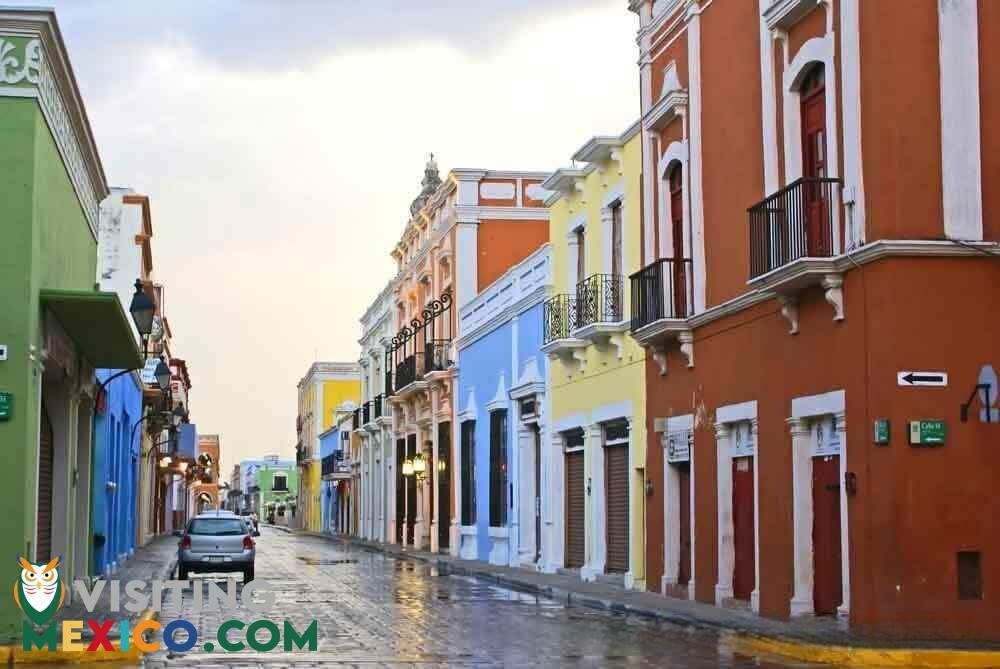IMPORTANT FACTS
ampeche has an area of 22,365 square miles. It is one of Mexico’s least populous states, with a population is 836,866 people. Its largest city is also its capital—San Francisco de Campeche. Oil production accounts for more than half of the state’s economy. The industry boomed in the seventies when oil was discovered in the Gulf in the shallow waters of the state. Mining and other industry are also important to Campeche. In some sections of the state where the land is amenable, agriculture and raising livestock are also important to some communities.
GEOGRAPHY AND LANDSCAPE IN CAMPECHE
While much of Campeche’s lands are flat, there are a series of rolling hills in the south known as the Sierra Alta. Moreover, the state is home to various types of rainforests as well as savannahs and mangrove wetlands near the coast. The landscape boasts cedar trees, mahogany, and palms, to name a few. Wildlife that makes their home in Campeche include ocelot, wild boar, puma, jaguar, rattlesnakes, coral snakes, iguana, toucans, and many other species. Campeche’s surface water is mostly contained in the southern part of the state, where estuaries are present. The coastal waters of the Gulf of Mexico are known for their populations of crab, sea bass, and small sharks. With its beautifully lush rain forests, it isn’t surprising that the state celebrates three main areas of protected lands. These lands are favorite destinations for eco-tourists who visit to hike, photograph or simply enjoy the flora and fauna of the Yucatan.
TOURISM IN CAMPECHE
- Calakmul: Nestled deep within the jungles of the Peten Basin, this Mayan archaeological site less than thirty miles from the Guatemalan border. As a major power center, Calakmul is a substantial site important to the study of Mayan history and culture.
- Catedral de Nuestra Senora de la Purisima Concepcion: The main site of the capital’s Plaza Principal, this cathedral and its Baroque façade is among the most recognizable features of the capital.
- Museo de la Arquitectura Maya: This capital museum is one of the most revered in the state. Its steles and other Mayan relics are meticulously preserved and popular among tourists to the state.
- Rio Bec: This collection of some seventy small archaeological sites is located within the range of Xpujil. Since it is impossible to reach the area during the rainy season, excavations have been slower-going than at other areas adding to the sites’ mysterious allure.
- Jardín Botánico Xmuch Haltún: This famed botanical garden is a must-see attraction of the capital city. It’s especially noted for its displays of endemic species.
OTHER THINGS TO SEE AND DO IN CAMPECHE
HISTORIC CENTER
- Campeche’s Historic Walls: The city’s colonial-era fortifications are among its most striking features. Walk along the walls and explore the bastions and gates.
- Cathedral of Campeche: A beautiful example of colonial-era architecture, this cathedral is a focal point in the city’s main square.
- Museo de la Arquitectura Maya: Located in a historic building, this museum provides insights into Maya architecture and the region’s history.
ARCHAEOLOGICAL SITES
- Calakmul: One of the largest and most important Maya cities, it’s located in the Calakmul Biosphere Reserve. The site features impressive pyramids and is surrounded by dense jungle.
- Edzná: Another significant Maya archaeological site, known for its well-preserved structures including the impressive Temple of the Five Floors.
NATURAL ATTRACTIONS
- Campeche Beaches: Enjoy the coastal areas like Playa Bonita and Playa de la Concha for relaxation and water activities.
- Biosphere Reserves: Besides Calakmul, there are other natural areas like the Ría Celestún Biosphere Reserve, known for its birdwatching opportunities, especially flamingos.
CULTURAL EXPERIENCES
- Traditional Festivals: Campeche hosts various festivals and cultural events throughout the year, such as the Carnival of Campeche and the Festival of the Maya Culture.
- Local Cuisine: Don’t miss trying local specialties like pan de cazon (a type of layered fish casserole) and other regional dishes.
DAY TRIPS AND ADVENTURES
- Island Visits: Explore nearby islands like Isla de Jaina, which has both natural beauty and archaeological significance.
- Cenotes and Natural Springs: Discover the cenotes, or natural sinkholes, in the region for swimming and exploring.
Whether you’re interested in exploring ancient ruins, enjoying natural beauty, or immersing yourself in local culture, Campeche has a rich array of experiences to offer.




